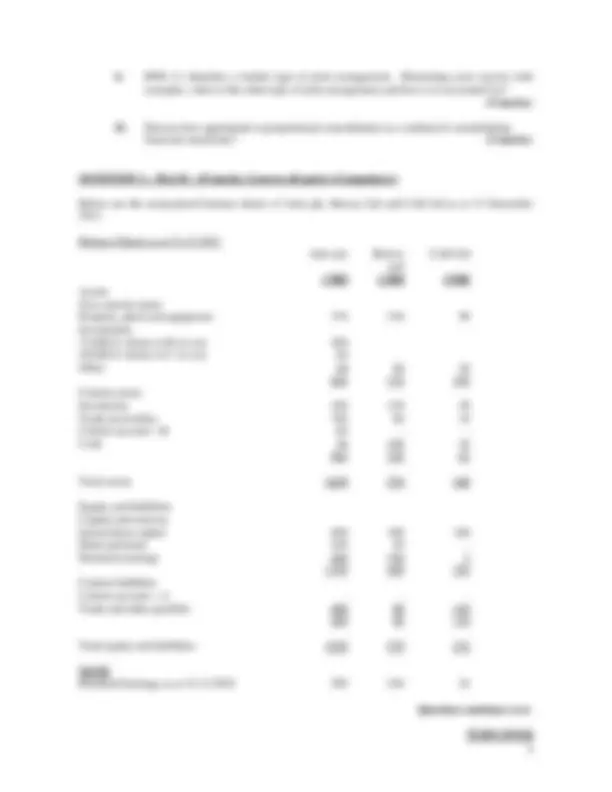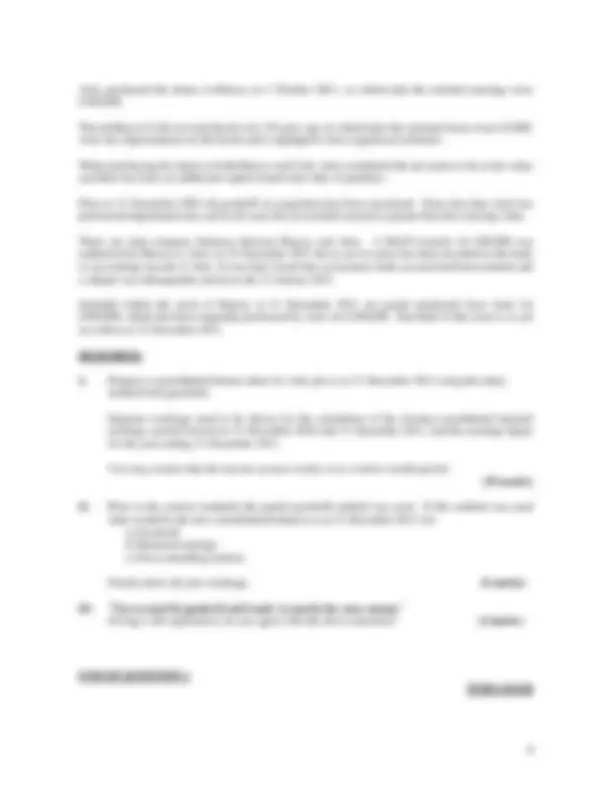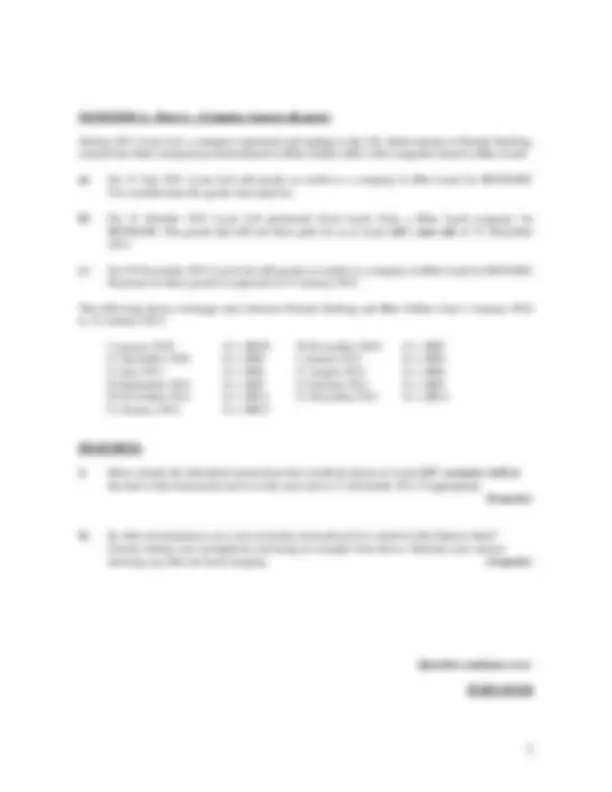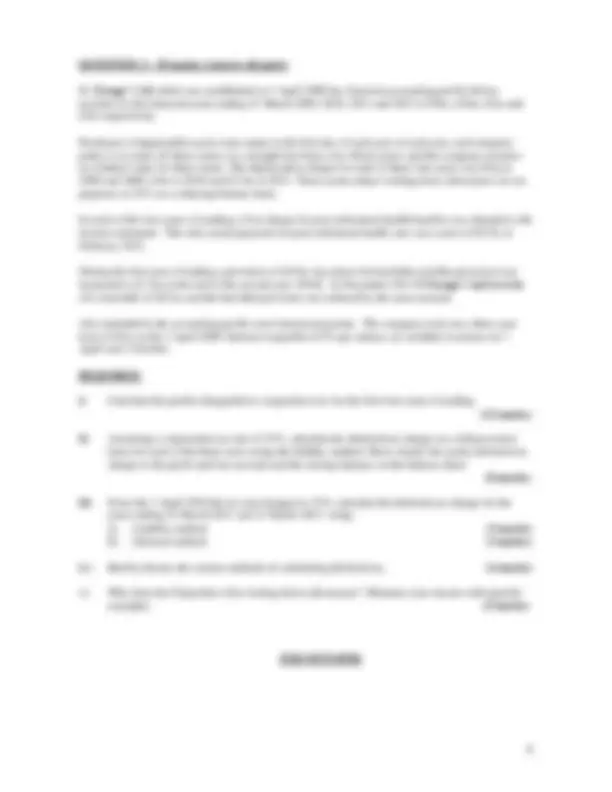






Study with the several resources on Docsity

Earn points by helping other students or get them with a premium plan


Prepare for your exams
Study with the several resources on Docsity

Earn points to download
Earn points by helping other students or get them with a premium plan
Community
Ask the community for help and clear up your study doubts
Discover the best universities in your country according to Docsity users
Free resources
Download our free guides on studying techniques, anxiety management strategies, and thesis advice from Docsity tutors
Balance Sheets, Venture Agreement, Share Profits, Financial Statements, Cost of Sales, Ordinary Activities, Current Assets, Sundry Assets, Equity and Liabilities, Capital and Reserves. Given points represent accounting and finance exam paper.
Typology: Exams
1 / 8

This page cannot be seen from the preview
Don't miss anything!





QUESTION 1 – Part A - 20 marks (Answer all parts) (Compulsory)
On 1/1/2011 Phoenix Ltd signed a joint venture agreement with Feathers Ltd to manufacture a solar powered home fire. A new business entity was established called Ashes Ltd. A contract was drawn up agreeing that both joint venturers would initially contribute £125,000 each and receive 125,000 £1 shares and share profits equally.
Below are summarised financial statements for Phoenix Ltd and Ashes Ltd the new joint venture for the year ending 31/12/2011:
Income Statements for the year ended 31/12/
Phoenix Ltd
Ashes Ltd
£’000 £’ Sales 1,600 350 Cost of sales 800 100 Profit on ordinary activities before taxation 800 250 Taxation 200 65 Profit on ordinary activities after taxation 600 185
Balance Sheets as at 31/12/ Phoenix Ltd
Ashes Ltd £’000 £’ Assets Non-Current Assets 1,800 350 125,000 £1 shares in Ashes at cost 125
Current Assets Sundry assets 200 85 2,125 435 Equity and Liabilities Capital and Reserves Share capital ordinary shares 500 250 Retained profit 1,625 185 2,125 435
i. Prepare a consolidated Income Statement for the year ended 31/12/2011 and consolidated Balance Sheet as at that date using:
a) Entity method for the joint venture (6 marks)
b) The method that is no longer allowed by IFRS 11 – Joint Arrangements (6 marks)
Question continues over
TURN OVER
Artic purchased the shares in Breezy on 1 October 2011, on which date the retained earnings were £300,000.
The holding in Cold was purchased over 30 years ago on which date the retained losses were £5,000. Artic has representation on the board and is adjudged to have significant influence.
When purchasing the shares in both Breezy and Cold, Artic considered the net assets to be at fair value and there has been no additional capital issued since date of purchase.
Prior to 31 December 2004 all goodwill on acquisition has been amortised. Since that date Artic has performed impairment tests and in all cases the recoverable amount is greater than the carrying value.
There are inter-company balances between Breezy and Artic. A BACS transfer for £60,000 was authorised by Breezy to Artic on 25 December 2011 but as yet no entry has been recorded in the bank or accounting records of Artic. It was later found that an incorrect bank account had been entered and a cheque was subsequently raised on the 12 January 2012.
Included within the stock of Breezy at 31 December 2011 are goods purchased from Artic for £400,000, which had been originally purchased by Artic for £100,000. One third of this stock is as yet un-sold as at 31 December 2011.
REQUIRED:
i) Prepare a consolidated balance sheet for Artic plc as at 31 December 2011 using the entity method (full goodwill).
Separate workings need to be shown for the calculation of the closing consolidated retained earnings carried forward at 31 December 2010 and 31 December 2011, and the earnings figure for the year ending 31 December 2011.
You may assume that the income accrues evenly over a twelve-month period. (35 marks)
ii) Prior to the current standards the partial goodwill method was used. If this method was used what would be the new consolidated balances as at 31 December 2011 for: a) Goodwill b) Retained earnings c) Non-controlling interest.
Clearly show all your workings. (6 marks)
iii) ‘You account for goodwill and brands in exactly the same manner’ Giving a full explanation, do you agree with the above statement? (4 marks)
QUESTION 2 – Part A – 12 marks (Answer all parts)
During 2011 Lynn Ltd, a company registered and trading in the UK which reports in Pounds Sterling, entered into three transactions denominated in Blue Dollars (B$) with companies based in Blue Land:
Two months later the goods were paid for.
B$200,000. The goods had still not been paid for as at Lynn Ltd’s year end of 31 December
Payment for these goods is expected on 31 January 2012.
The following shows exchange rates between Pounds Sterling and Blue Dollars from 1 January 2010 to 31 January 2012:
1 January 2010 £1 = B$10 30 November 2010 £1 = B$ 31 December 2010 £1 = B$9 1 January 2011 £1 = B$ 31 July 2011 £1 = B$8 31 August 2011 £1 = B$ 30 September 2011 £1 = B$9 31 October 2011 £1 = B$ 30 November 2011 £1 = B$11 31 December 2011 £1 = B$ 31 January 2012 £1 = B$
i) Show clearly the individual transactions that would be shown in Lynn Ltd’s accounts, both at the date of the transaction and as at the year end of 31 December 2011 if appropriate. (8 marks)
ii) In what circumstances can a non-monetary transaction be re-stated on the balance sheet? Clearly stating your assumptions and using an example from above, illustrate your answer showing any relevant book-keeping. (4 marks)
Question continues over
TURN OVER
i) Using the Temporal Method translate Redstars Inc’s balance sheet and income statement for the years ending 31 December 2010 and 31 December 2011. (16 marks)
ii) How does the CRNI method differ from the temporal method and in what circumstances is the temporal method more appropriate? (4 marks)
iii) Using an example, show clearly the three types of currencies that IAS 21 recognises. (3 marks)
QUESTION 3 – 35 marks (Answer all parts)
St. George’s Ltd which was established on 1 April 2008 has financial accounting profits before taxation for the financial years ending 31 March 2009, 2010, 2011 and 2012 of £9m, £10m, £2m and £5m respectively.
Purchases of depreciable assets were made on the first day of each year in each year, and company policy is to write off these assets on a straight line basis over fifteen years and the company assumes no residual value for these assets. The depreciation charge for each of these four years was £4m in 2008 and 2009, £5m in 2010 and £5.5m in 2011. These assets attract writing down allowances for tax purposes at 25% on a reducing balance basis.
In each of the four years of trading a £1m charge for post-retirement health benefits was charged to the income statement. The only actual payment for post-retirement health care was a sum of £0.1m in February 2012.
During the first year of trading a provision of £0.5m was taken for bad debts and this provision was increased to £1.5m at the end of the second year (2010). In December 2011 St George’s had to write off a bad debt of £0.2m and the bad debt provision was reduced by the same amount.
Also included in the accounting profits were interest payments. The company took out a three year loan of £5m on the 1 April 2008. Interest is payable at 5% per annum, six monthly in arrears on 1 April and 1 October.
i) Calculate the profits chargeable to corporation tax for the first four years of trading. (12 marks)
ii) Assuming a corporation tax rate of 23%, calculate the deferred tax charge on a full provision basis for each of the three years using the liability method. Show clearly the yearly deferred tax charge to the profit and loss account and the closing balance on the balance sheet. (8 marks)
iii) From the 1 April 2010 the tax rate changes to 15%, calculate the deferred tax charge for the years ending 31 March 2011 and 31 March 2012 using:
iv) Briefly discuss the various methods of calculating deferred tax. (4 marks)
v) Why does the Chancellor offer writing down allowances? Illustrate your answer with specific examples. (5 marks)